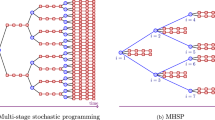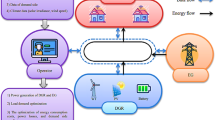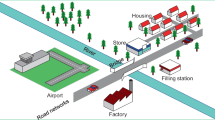Abstract
This paper is based on Groschke et al. (Z. Energiewirtsch. 33(1):14–22 2009) and continues the description of new developments in modeling network constraints in techno-economic energy system models with a focus on capacity expansion planning and a long-term time horizon. Based on the presentation of recent and future developments in the German energy system, current challenges in energy system modeling are derived. The following analysis of the state of research reveals a lack of high-precision load flow calculation in current energy system models with a long-term time horizon. Hence, this paper presents an outlook on a new mathematical approach, which already proved as a promising method to meet the challenges identified.
Zusammenfassung
Diese Arbeit basiert auf Groschke et al. (Z. Energiewirtsch. 33(1):14–22 2009) und setzt die Beschreibung neuer Entwicklungen im Bereich der Integration technischer Netzrestriktionen in techno-ökonomischen Energiesystemmodellen mit Fokus auf der Kraftwerksausbauplanung und einem langfristigen Zeithorizont fort. Basierend auf der Präsentation aktueller und zukünftiger Entwicklungen im deutschen Energiesystem werden zunächst Anforderungen an zukünftige Energiesystemmodelle abgeleitet. Die folgende Analyse des derzeitigen Forschungsstandes auf diesem Gebiet zeigt einen Mangel an Modellen mit langfristigem Zeithorizont in Verbindung mit hochpräzisen Lastflussberechnungsmethoden auf. Deshalb wird im Rahmen dieser Arbeit ein erster Ausblick auf eine neue mathematische Herangehensweise gegeben, welche sich bereits als vielversprechender Ansatz erwiesen hat, um den identifizierten Herausforderungen gerecht zu werden.
Similar content being viewed by others
References
Apfelbeck J (2009) Simultane Optimierung des Kraftwerks- und Netzausbaus am Beispiel von Deutschland. VDI-Ber 2080:29–44
Barth R, Rudion K, Heyde C, Swider D, Styczynski Z (2007) Improved consideration of the power grid in stochastic electricity market models dealing with distributed generation. In: CIRED 19th International conference on electricity distribution, chap. 0636
Barth R, Apfelbeck J, Vogel P, Meiborn P, Weber C (2009) Load-flow based market coupling with large-scale wind power in Europe. In: 8th workshop on large-scale integration of wind power into power systems as well as on transmission networks for offshore wind farms
Bundesnetzagentur (2011) Monitoringbericht 2010. Bundesnetzagentur für Elektrizität, Gas, Telekommunikation, Post und Eisenbahnen – Monitoring, Marktbeobachtung. Bonn
CONSENTEC, EWI, IAEW (2008) Analyse und Bewertung der Versorgungssicherheit in der Elektrizitätsversorgung (Monitoringbericht nach §51 EnWG). Bundesministerium für Wirtschaft und Technologie (BMWi), Berlin
Das J (2002) Power system analysis—short-circuit load flow and harmonics. Dekker, New York
DENA (2010) DENA-Netzstudie II: Integration erneuerbarer Energien in die deutsche Stromversorgung im Zeitraum 2015–2020 mit Ausblick 2025. DENA, Berlin
Dietrich K, Leuthold F, Weigt H (2010) Will the market get it right? The placing of new power plants in Germany. Z Energiewirtsch 34:255–265
Ding F, Fuller D (2005) Nodal, uniform, or zonal pricing: distribution of economic surplus. IEEE Trans Power Syst 20(2):875–882
Duthaler C (2009) Europe nodal: a simulation of the European electricity market based on the full network model. In: Second annual conference on competition and regulation in network industries. Center for European Studies
EnLAG (2009) Gesetz zur Beschleunigung des Ausbaus der Höchstspannungsnetze vom 21. August 2009. BGBl I(55):2870–2876
Eßer A, Moest D, Rentz O (2008) Long-term power plant investment planning in Baden-Wuerttemberg using a GIS-based nodal pricing approach. In: Proceedings of the 31st IAEE international conference “Bridging energy supply and demand: logistics, competition and environment”
Eßer-Frey A, Fichtner W (2011) Analyzing the regional development of the German power system using a nodal pricing approach. In: Proceedings of the 8th conference on the European electricity market (EEM)
Green R (2004) Electricity transmission pricing: how much does it cost to get it wrong? CMI working paper
Groschke M, Eßer A, Möst D, Fichtner W (2009) Neue Anforderungen an optimierende Energiesystemmodelle für die Kraftwerkseinsatz- und Zubauplanung bei begrenzten Netzkapazitäten. Z Energiewirtsch 33(1):14–22
Handschin E, Kuhn S, Rehtanz C, Schultz R, Waniek D (2009) Optimaler Kraftwerkseinsatz in Netzengpasssituationen. In: Schultz R, Wagner HJ (eds) Innovative Modellierung und Optimierung von Energiesystemen. Verlag Dr. W. Hopf, Wien, Chap 3, pp 39–68
Leuthold F (2010) Economic engineering modeling of liberalized electricity markets: approaches, algorithms, and applications in the European context. Dissertation, Technische Universität Dresden, Dresden
Leuthold F, Weigt H, v Hirschhausen C (2008) Efficient pricing for European electricity networks—the theory of nodal pricing applied to feeding-in wind in Germany. Util Policy 16:284–291
Leuthold F, Weigt H, v Hirschhausen C (2010) A large-scale spatial optimization model of the european electricity market. Netw Spat Econ. doi:10.1007/s11067-010-9148-1
Murillo-Sánchez C, Thomas R (2001) Thermal unit commitment with a nonlinear AC power flow network model. In: Hobbs BF et al. (eds) The next generation of electrical power unit commitment models. Kluwer Academic, Norwell, pp 75–92, chap 5
Overbye T, Cheng X, Sun Y (2004) A Comparison of the AC and DC power flow models for LMP calculations. In: Proceedings of the 37th Hawai international conference on system science
Powell L (2004) Power system load flow analysis. McGra-Hill, New York
Purchala K, Meeus L, Belmans R (2005) Zonal network model of European interconnected electricity network
Schweppe F, Caraminis M, Tabor R, Bohn R (1987) Spot pricing of electricity. Kluver Academic, New York
Stamtsis G (2004) Power transmission cost calculation in deregulated electricity market. Logos, Berlin
Stamtsis G, Christensen J, Erlich I (2002) Evaluation of power systems congestion using nodal price analysis. In: Proceedings of the international symposium MEPS, pp 25–30
Stigler H, Todem C (2004) Optimization of the Austrian electricity sector (control zone of VERBUND APG) under the constraint of network capacities by nodal pricing. Cent Eur J Oper Res 13:105–125
Stoer J, Jarre F (2004) Optimierung. Springer, Berlin
Sun J, Tesfatsion L (2006) DC optimal power flow formulation and solution using QuadProgJ. Department of Economics working paper series, vol 06014. Iowa State University
Waniek D, Häger U, Rehtanz C, Handschin E (2008) Influences of wind energy on the operation of transmission systems. In: IEEE power and energy society general meeting. Conversion and delivery of electrical energy in the 21st century, pp 1–8
Waniek D, Rehtanz C, Handschin E (2010) Flow-based evaluation of congestions in the electric power transmission system. In: EEM 2010: 7th conference on the European energy market
Weigt H (2006) A time-variant welfare economic analysis of a nodal pricing mechanism in Germany. In: Proceeding of the 5th conference on applied infrastructure research
Weigt H, Jeske T, Leuthold F, v Hirschhausen C (2010) Take the long way down: integration of large-scale North Sea wind using HVDC transmission. Energy Policy 38:3164–3173
Author information
Authors and Affiliations
Corresponding author
Rights and permissions
About this article
Cite this article
Schönfelder, M., Eßer-Frey, A., Schick, M. et al. New Developments in Modeling Network Constraints in Techno-economic Energy System Expansion Planning Models. Z Energiewirtsch 36, 27–35 (2012). https://doi.org/10.1007/s12398-011-0067-8
Published:
Issue Date:
DOI: https://doi.org/10.1007/s12398-011-0067-8




